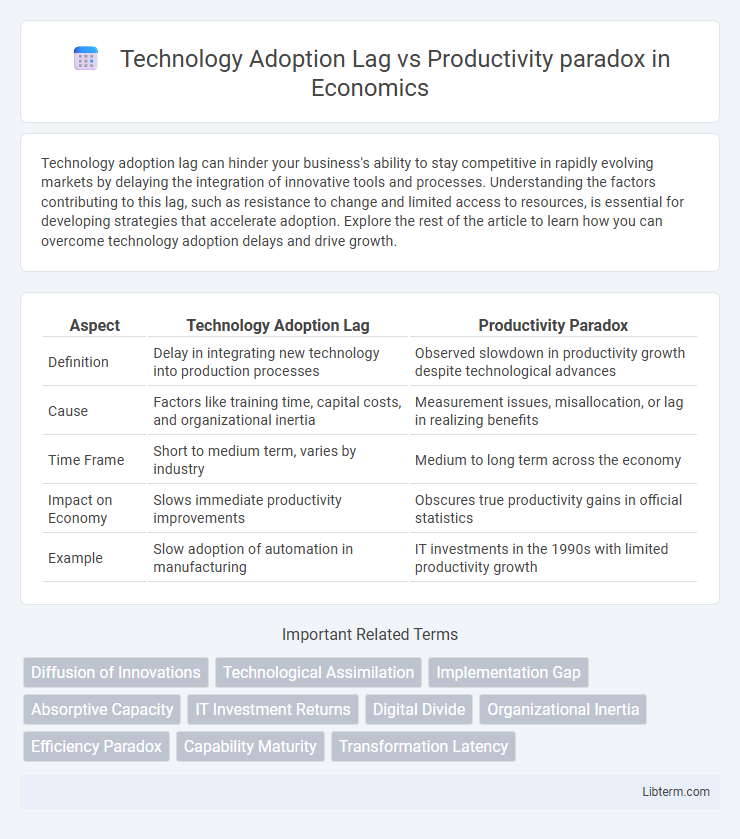Technology adoption lag can hinder your business's ability to stay competitive in rapidly evolving markets by delaying the integration of innovative tools and processes. Understanding the factors contributing to this lag, such as resistance to change and limited access to resources, is essential for developing strategies that accelerate adoption. Explore the rest of the article to learn how you can overcome technology adoption delays and drive growth.
Table of Comparison
| Aspect | Technology Adoption Lag | Productivity Paradox |
|---|---|---|
| Definition | Delay in integrating new technology into production processes | Observed slowdown in productivity growth despite technological advances |
| Cause | Factors like training time, capital costs, and organizational inertia | Measurement issues, misallocation, or lag in realizing benefits |
| Time Frame | Short to medium term, varies by industry | Medium to long term across the economy |
| Impact on Economy | Slows immediate productivity improvements | Obscures true productivity gains in official statistics |
| Example | Slow adoption of automation in manufacturing | IT investments in the 1990s with limited productivity growth |
Understanding Technology Adoption Lag
Technology adoption lag refers to the delay between the introduction of new technologies and their widespread integration into business processes, which can obscure immediate productivity gains. Factors such as employee training, infrastructure upgrades, and organizational resistance contribute to this lag, slowing the realization of expected efficiency improvements. Understanding these barriers is essential to addressing the productivity paradox, where increased technology investment does not immediately translate into measurable output growth.
Defining the Productivity Paradox
The productivity paradox refers to the observed discrepancy where significant investments in information technology do not immediately translate into measurable gains in productivity. This phenomenon occurs because new technologies often require time for effective integration, employee adaptation, and process optimization before impacting output. Understanding this lag helps organizations set realistic expectations and develop strategies to bridge the gap between technological adoption and performance improvement.
Historical Perspectives on Technology and Productivity
Historical perspectives on technology adoption lag reveal that new technologies often require decades to fully integrate into productive use, delaying observable gains in productivity. The productivity paradox, first noted during the computer revolution of the late 20th century, highlights periods when significant investments in information technology did not immediately translate into measurable output growth. Studies on past industrial revolutions show that productivity improvements frequently follow technological innovations only after complementary changes in skills, organizational structures, and infrastructure occur.
Key Factors Slowing Technology Adoption
Key factors slowing technology adoption include high implementation costs, lack of skilled workforce, and organizational resistance to change. Infrastructure limitations and regulatory constraints also contribute significantly to delays in integrating new technologies. These barriers create a gap between technological advancements and measurable productivity gains, explaining the persistence of the productivity paradox.
Measuring Productivity in the Digital Age
Measuring productivity in the digital age requires analyzing output relative to inputs while accounting for technology adoption lag, which often delays the observable benefits of innovation on economic performance. The productivity paradox highlights that initial introduction of digital tools may not immediately translate to productivity gains due to learning curves, integration challenges, and shifts in organizational processes. Utilizing advanced metrics like real-time data analytics, multifactor productivity indexes, and sector-specific performance indicators can better capture the nuanced impact of digital technologies over time.
Case Studies: Delayed Tech Adoption and Productivity Outcomes
Case studies on technology adoption lag reveal that delayed integration of innovations such as automation and AI often results in slower productivity growth, as seen in manufacturing sectors resistant to early digital transformation. In contrast, firms that adopt technologies promptly tend to experience immediate efficiency gains, highlighting a direct correlation between adoption speed and productivity outcomes. This evidence challenges the productivity paradox by showing that the lag itself, rather than technology inefficacy, explains stagnant productivity metrics.
Organizational Barriers to Technology Integration
Organizational barriers to technology integration, such as resistance to change, lack of employee training, and rigid hierarchical structures, significantly contribute to the technology adoption lag and the productivity paradox. Companies often underutilize advanced technologies due to misaligned incentives, inadequate resource allocation, and poor communication between IT and business units. These obstacles delay the realization of productivity gains despite early investments in cutting-edge technologies like AI, IoT, and automation.
Strategies to Bridge the Adoption-Productivity Gap
Implementing targeted training programs accelerates employee proficiency with new technologies, reducing the adoption lag and enhancing productivity. Organizations should leverage data analytics to monitor technology usage patterns, enabling timely adjustments and support to maximize value extraction. Strategic integration of technology with existing workflows ensures smoother transitions, minimizing disruptions and fostering measurable productivity gains.
The Role of Policy in Accelerating Productivity Gains
Policy frameworks that incentivize research and development investments, such as tax credits and grants, accelerate technology adoption, thereby reducing the technology adoption lag. Regulatory adjustments that streamline approval processes for innovative technologies enable faster integration into business operations, driving immediate productivity gains. Strategic government initiatives fostering digital infrastructure and skills development bridge the gap between technology availability and effective utilization, addressing the productivity paradox.
Future Trends: Overcoming the Technology-Productivity Disconnect
Future trends in overcoming the technology-productivity disconnect emphasize accelerating the diffusion of digital innovations across industries through strategic investments in workforce upskilling and organizational change management. Enhanced data analytics, AI-driven process automation, and real-time performance monitoring are enabling firms to translate technological advancements into measurable productivity gains more rapidly. Collaborative platforms and adaptive learning systems also play critical roles in minimizing adoption lag by fostering continuous knowledge transfer and agile responses to evolving market demands.
Technology Adoption Lag Infographic

 libterm.com
libterm.com